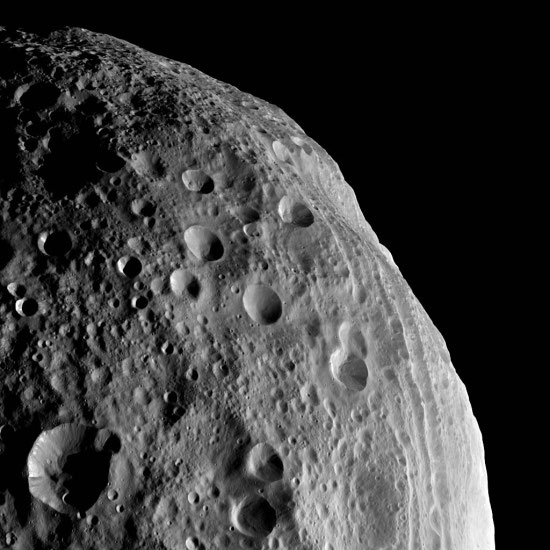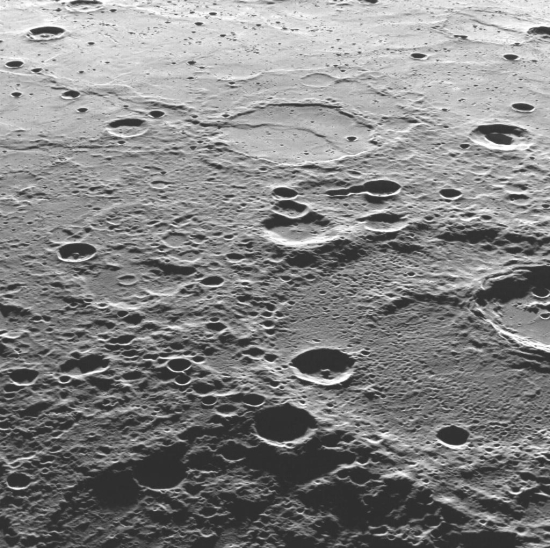Craters, craters, everywhere
Below the fold are two images released today, one from Dawn at Vesta and the other from Messenger at Mercury. What makes them interesting to me is that, though the surfaces of both Vesta and Mercury are crater-packed, there are definitely distinct differences between them that one can spot if you look closely, all highlighting the fundamentally different environments of both worlds.
First, the Vesta photograph. The image looks out past the asteroid’s horizon, showing clearly that this dwarf planet is not spherical, with the south pole depression that puzzles scientists just on the planet’s limb. The parallel long deep grooves that are associated with this depression can be seen on the right. Notice also that the inside walls of all the craters slope downward in a very shallow manner. This gives the impression that the impacts that formed these craters smashed into an almost beachlike sandy surface. Note too the that the center of some craters have what appear to be flat small “ponds,” a phenomenon seen by the spacecraft NEAR when it orbited the asteroid Eros. These ponds are not liquid, but are actually made up of fine-grained particles that settle in the hollows of the asteroid.

For Vesta, these effects probably come from the asteroid’s relatively low gravity, which acts to keep the overall density of its material low.
Then there is the Messenger image looking east across a cratered Mercury plain. Here the craters generally appear to be more shallow, at least relative to the surrounding terrain. Also, the terrain seems more rounded and worn, its rough edges smoothed by eons of wear from the solar wind and the harsh radiation of the nearby sun. In fact, the largest crater in the image (filling the right-bottom quarter of the picture) has almost vanished with wear over time. You can also see one of Mercury’s unique scarps cutting through the crater at the top of the image. These scarps were created as Mercury slowly solidified and shrank.

While both worlds appear very similar at first glance, this quick close look illustrates once again a very consistent finding by planetary scientists since the beginning of the space age: every object orbiting the sun is uniquely different, sometimes wildly so. Because of this scientists have learned never to be surprised by what they see once they get a chance to take a close look.
For this reason, expect some big surprises when New Horizons finally flies past Pluto in July 2015.
On Christmas Eve 1968 three Americans became the first humans to visit another world. What they did to celebrate was unexpected and profound, and will be remembered throughout all human history. Genesis: the Story of Apollo 8, Robert Zimmerman's classic history of humanity's first journey to another world, tells that story, and it is now available as both an ebook and an audiobook, both with a foreword by Valerie Anders and a new introduction by Robert Zimmerman.
The print edition can be purchased at Amazon or from any other book seller. If you want an autographed copy the price is $60 for the hardback and $45 for the paperback, plus $8 shipping for each. Go here for purchasing details. The ebook is available everywhere for $5.99 (before discount) at amazon, or direct from my ebook publisher, ebookit. If you buy it from ebookit you don't support the big tech companies and the author gets a bigger cut much sooner.
The audiobook is also available at all these vendors, and is also free with a 30-day trial membership to Audible.
"Not simply about one mission, [Genesis] is also the history of America's quest for the moon... Zimmerman has done a masterful job of tying disparate events together into a solid account of one of America's greatest human triumphs."--San Antonio Express-News


A. A gap is located at an average orbital distance, and asteroid orbits often have large eccentricities.
B. They are held in place by resonances with other asteroids.
C.Jupiter’s gravitational tugs keep them there.
D.Actually, we never see asteroids in the gaps.
E.They are kept in place by shepherding asteroids.